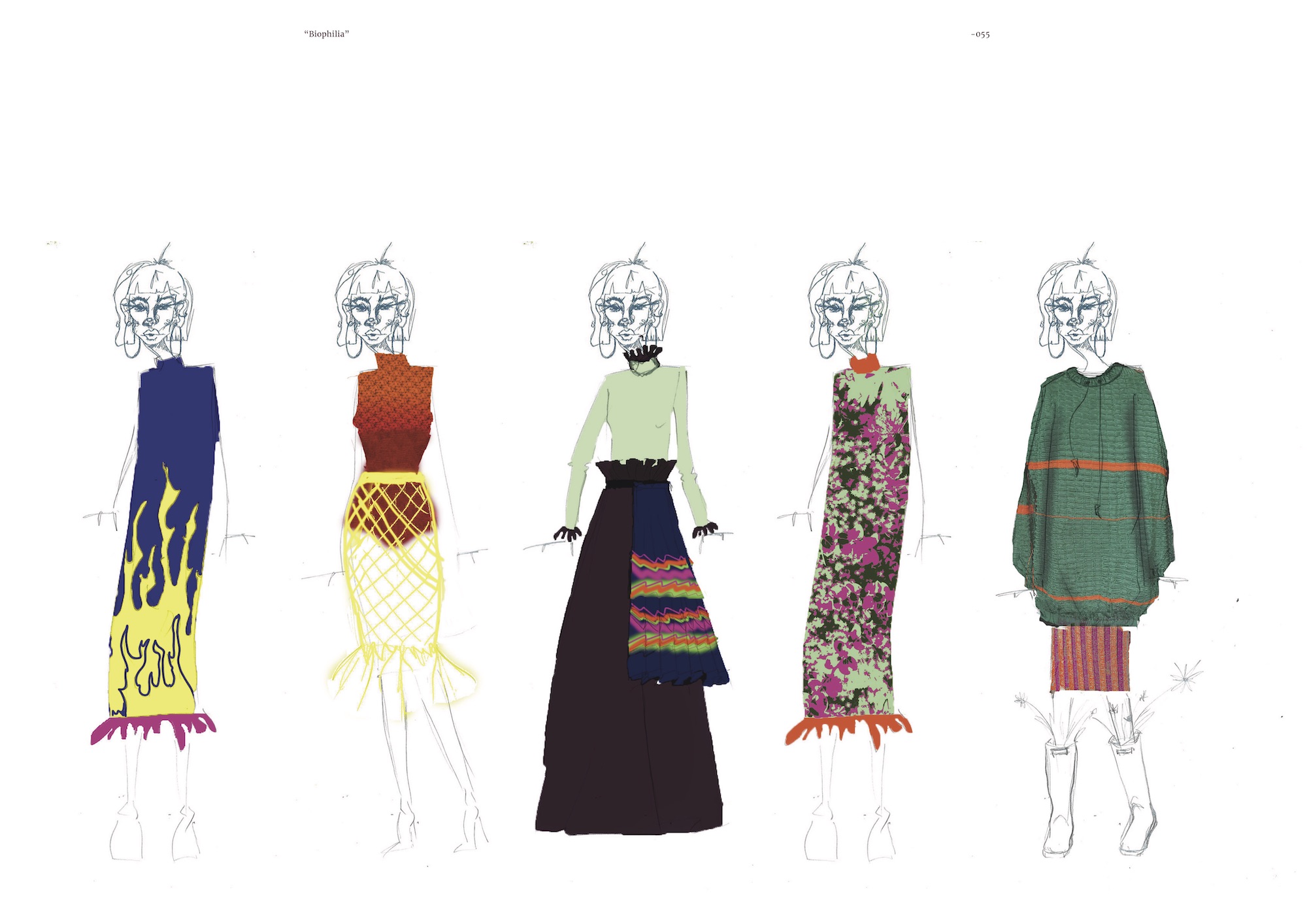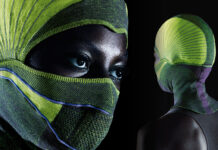
Amsterdam born Chloë Severien is a graduate knitwear designer with an ethos of reusability embedded in her textiles. Of course, working within the context of sustainable fashion (particularly as a student with limited access to industry resources and financial support), is not without its challenges. Achieving a balance of pushing herself to achieve ‘sustainability targets’ whilst also recognising that she couldn’t achieve them all was a learning process that Chloë embraced. She has taken the inherent properties of knitted structures, and elevated them with industry research, creating a catalyst for innovation.
Chloë’s collection was created with PET Yarns (made from recycled plastic bottles). She designed zero waste patterns allowing yarns to unravel with ease at the end of the garment’s life- theoretically facilitating reknitting. Utilising yarn from a rather surprising industry, Chloë found a unique solution to degradation of fibre quality that is a primary inhibitor to the recycling and re knitting of yarns.
Completing most of her undergraduate study at ArtEZ, during her third year Chloë moved to Willem De Kooning Academy to complete her studies. The unique combination of her two experiences is what she feels has formed her creative yet inquisitive approach to knitwear design. Chloë graduated in Summer 2019 with her collection of “Infinitely Reusable Knitwear” and is now based at her home studio in Rotterdam.
My first word was ‘Molen’, Dutch for a mill, as my mom took me on bike rides along the mills a lot. Chloë Severien.
Interested in fabrics and creativity throughout her childhood, Chloë first discovered her interest specifically in sustainable textiles during her gap year travelling in Cambodia. Here, she volunteered on an eco-farm where they made, built and grew from what the jungle gave them. An internship at Studio M.E.N who were focussing on zero waste pattern cutting, combined with watching the documentary ‘The True Cost’ were defining influences in Chloë ‘s development as a designer, when she realised the imperative to contribute to a more sustainable knitwear industry. These experiences altered her views on fashion, production and even ways of living. She began introducing a zero-waste lifestyle and started to explore system changes for fashion; here is where her concept began to form.
What if we use what we have already produced. And not only once, but endlessly? Chloë Severien.
It was imperative to Chloë that she understood the full extent of the issues she was addressing. The amount of research necessary was overwhelming for her at times, as she was keen to avoid doing more harm than good; this is often a pitfall of uninformed yet well-intentioned design decisions. Chloë undertook academic research into material properties and production methods in the knitwear industry. She discovered the issues surrounding petrochemical based yarns and their slow rates of biodegradability. Realising that recycled organic yarn was too brittle for her to achieve the reusability factor, she selected PET-yarn – so strong that it can be used over and over again- avoiding landfill.
Chloë’s theory is that when knitted in such a way it can unravel, and when garment pieces are shaped, there is zero waste and once the garment comes to the end of it’s life, the yarn can be reused again and again in a ‘Cradle to Cradle’ inspired approach.

For her graduate collection, Chloë focussed on using PET yarns originally intended for industrial production of car tyres! Their strength is what attracted her to this unconventional yarn for fashion. These yarns have a silky lustrous shine- taking colour well- and despite their strength they are surprisingly soft and malleable. The colours for her collection were selected from chips of plastic waste she found in her home. Her colour swatches were sent directly to the yarn manufacturer who colour matched them.
Beginning with a sampling stage of developing her textiles, Chloë follows natural instinct with her colour choices. Inspired by her travels, nature and stitch structures within new techniques she develops her fabrics as a self-professed “perfectionist”. With creative fluidity Chloë revisits her paperwork and draws from her samples, allowing her fabrics to lead silhouette formation. Initially sampling on her Brother domestic machine, she refined her fabrics and achieved a more luxurious handle through collaborating with Knitwearlab, knitting fabrics for her final collection on fine gauge Stoll Machines.

With such a successful graduate collection now ‘in the bag’, Chloë is focussing on keeping her collection and techniques relevant and in the spotlight. Making connections with possible manufacturers close to home to create a circular business model, she is planning to test her yarns in collaboration with university labs before she can confidently take her fabrics to market.
On reflection, Chloë explained her new challenges:
“Microfibre shedding from my garments during washing is now my main concern with my system. I have talked to the Plastic Soup Foundation and due to the way the PET yarn is produced, their prediction is that the amount of microfibre shedding during the washing process will be very low. But I do want to know that for sure before bringing my product to the market. So testing and improving my yarn is now on the agenda.”

Chloë’s constant process of self-reflection is admirable. Designers setting themselves challenges with research-focussed approaches are arguably the industry’s best hope of actual, meaningful change within sustainable design. Acknowledging that she alone could not solve all the problems, but focussing on the differences she could make is an admirable feat as a student and now new designer. Determined to refine her material palette and attain certification for her processes, it would be brilliant to see Chloë’s further collaborations with industry specialists materialise in a truly resolved product.
Never one to aim small, Chloë shared her dreams for the future!:
“I want to buy a castle in Southern France, renovate it completely and start a knitting company with industrial knitting machines in one of the outbuildings. Living self-sufficiently with sheep and alpacas running around, from which we can spin the fibres to make beautiful pieces with love and care. That’s the dream. Can you picture it?”

Subscribe To Our Newsletter
Join our mailing list to receive the latest news and updates from our team.






